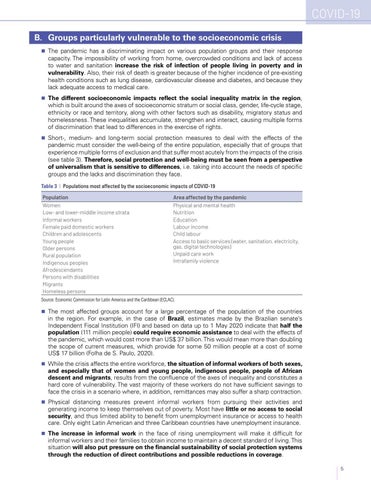COVID-19 B. Groups particularly vulnerable to the socioeconomic crisis The pandemic has a discriminating impact on various population groups and their response
capacity. The impossibility of working from home, overcrowded conditions and lack of access to water and sanitation increase the risk of infection of people living in poverty and in vulnerability. Also, their risk of death is greater because of the higher incidence of pre-existing health conditions such as lung disease, cardiovascular disease and diabetes, and because they lack adequate access to medical care.
The different socioeconomic impacts reflect the social inequality matrix in the region,
which is built around the axes of socioeconomic stratum or social class, gender, life-cycle stage, ethnicity or race and territory, along with other factors such as disability, migratory status and homelessness. These inequalities accumulate, strengthen and interact, causing multiple forms of discrimination that lead to differences in the exercise of rights.
Short-, medium- and long-term social protection measures to deal with the effects of the
pandemic must consider the well-being of the entire population, especially that of groups that experience multiple forms of exclusion and that suffer most acutely from the impacts of the crisis (see table 3). Therefore, social protection and well-being must be seen from a perspective of universalism that is sensitive to differences, i.e. taking into account the needs of specific groups and the lacks and discrimination they face.
Table 3 | Populations most affected by the socioeconomic impacts of COVID-19 Population Women Low- and lower-middle income strata Informal workers Female paid domestic workers Children and adolescents Young people Older persons Rural population Indigenous peoples Afrodescendants Persons with disabilities Migrants Homeless persons
Area affected by the pandemic Physical and mental health Nutrition Education Labour income Child labour Access to basic services (water, sanitation, electricity, gas, digital technologies) Unpaid care work Intrafamily violence
Source: Economic Commission for Latin America and the Caribbean (ECLAC).
The most affected groups account for a large percentage of the population of the countries
in the region. For example, in the case of Brazil, estimates made by the Brazilian senate’s Independent Fiscal Institution (IFI) and based on data up to 1 May 2020 indicate that half the population (111 million people) could require economic assistance to deal with the effects of the pandemic, which would cost more than US$ 37 billion. This would mean more than doubling the scope of current measures, which provide for some 50 million people at a cost of some US$ 17 billion (Folha de S. Paulo, 2020).
While the crisis affects the entire workforce, the situation of informal workers of both sexes,
and especially that of women and young people, indigenous people, people of African descent and migrants, results from the confluence of the axes of inequality and constitutes a hard core of vulnerability. The vast majority of these workers do not have sufficient savings to face the crisis in a scenario where, in addition, remittances may also suffer a sharp contraction.
Physical distancing measures prevent informal workers from pursuing their activities and
generating income to keep themselves out of poverty. Most have little or no access to social security, and thus limited ability to benefit from unemployment insurance or access to health care. Only eight Latin American and three Caribbean countries have unemployment insurance.
The increase in informal work in the face of rising unemployment will make it difficult for
informal workers and their families to obtain income to maintain a decent standard of living. This situation will also put pressure on the financial sustainability of social protection systems through the reduction of direct contributions and possible reductions in coverage.
5

